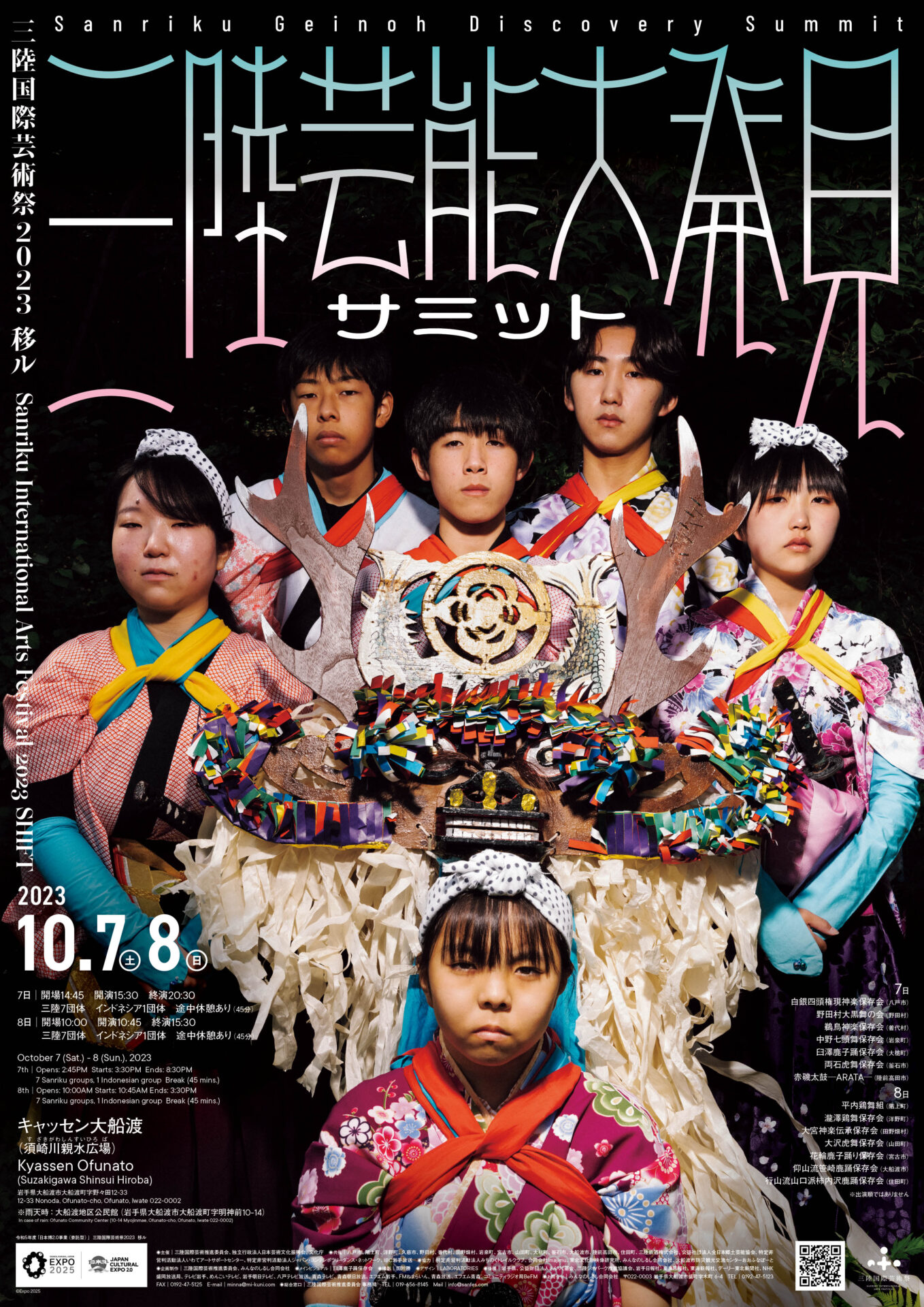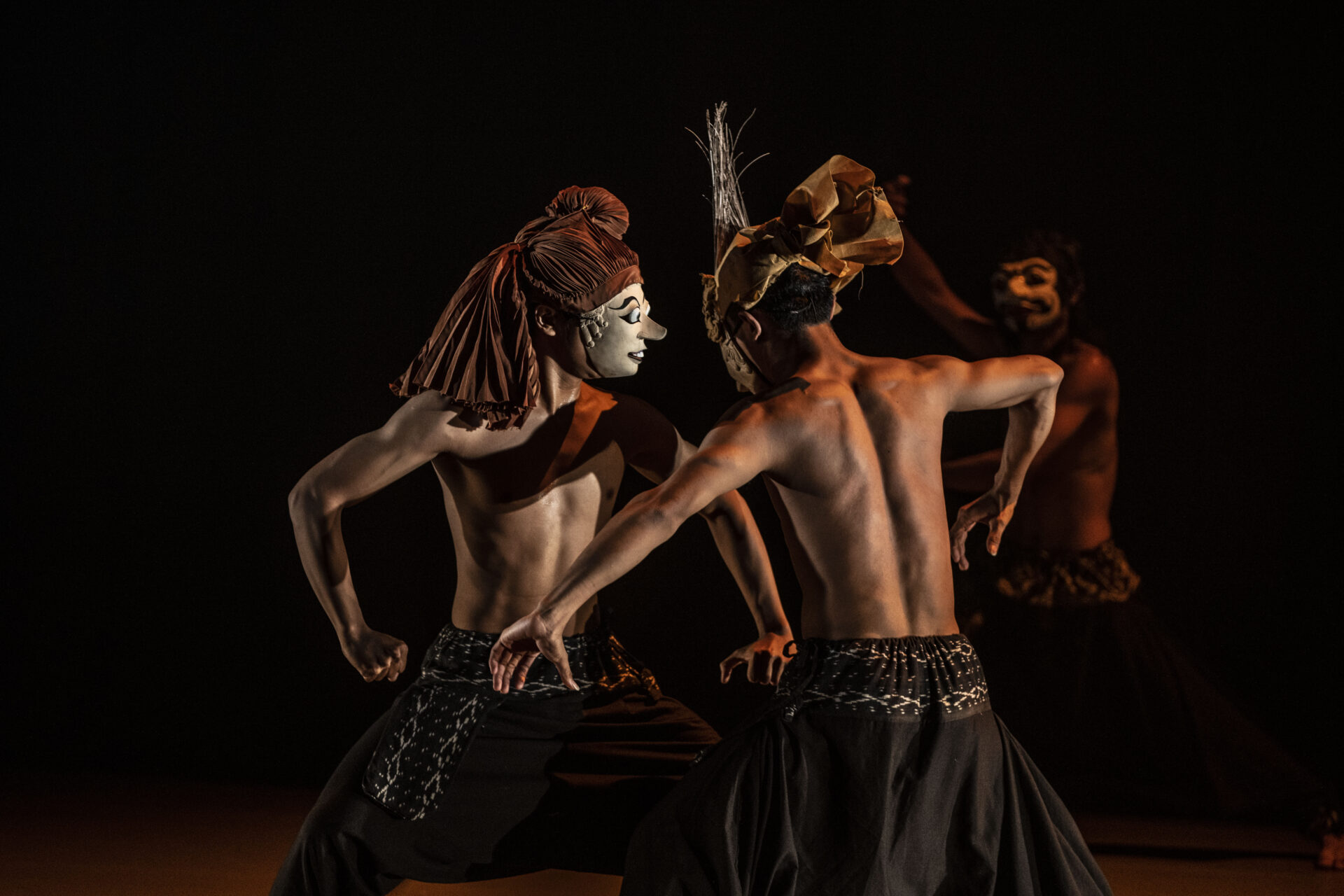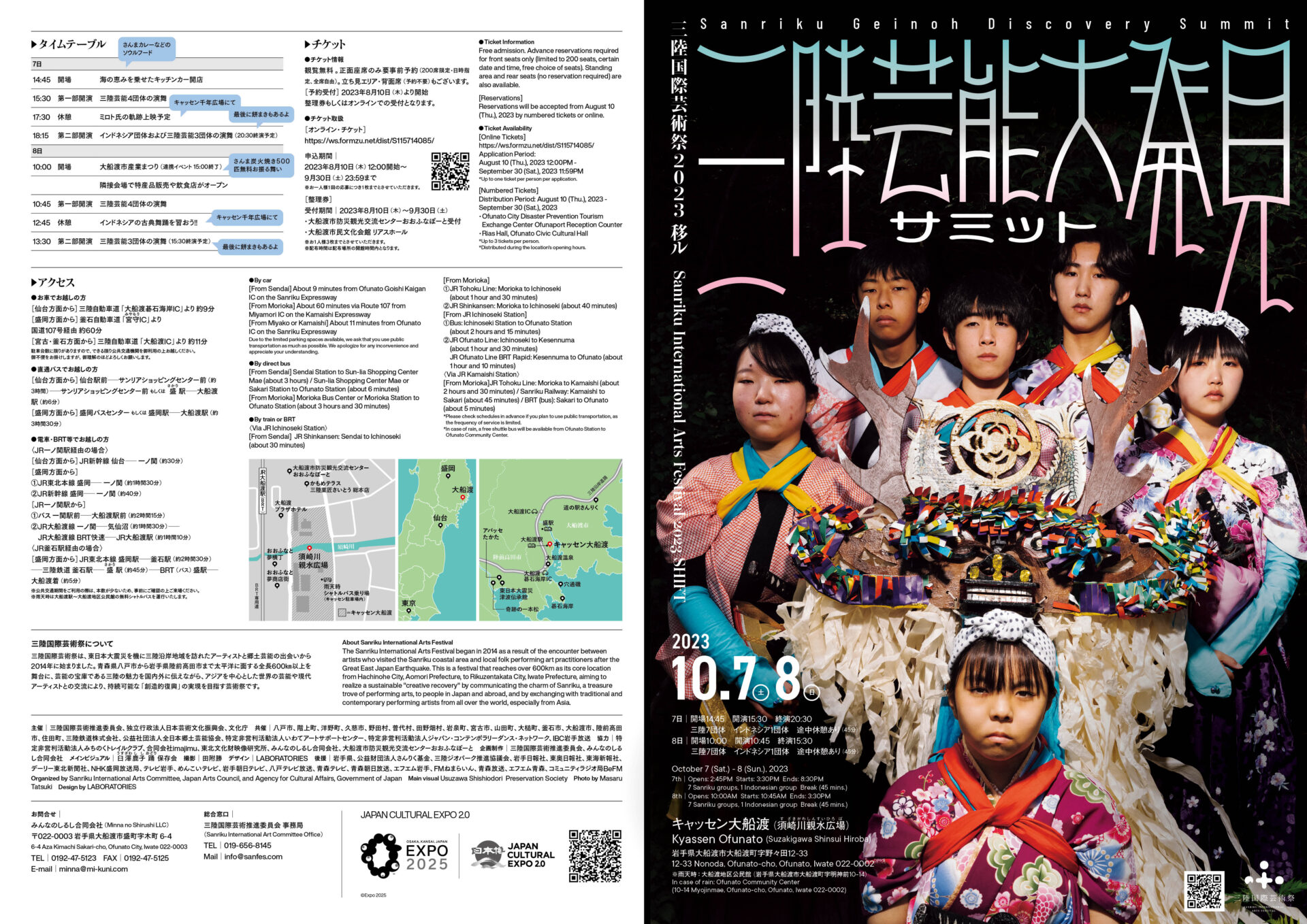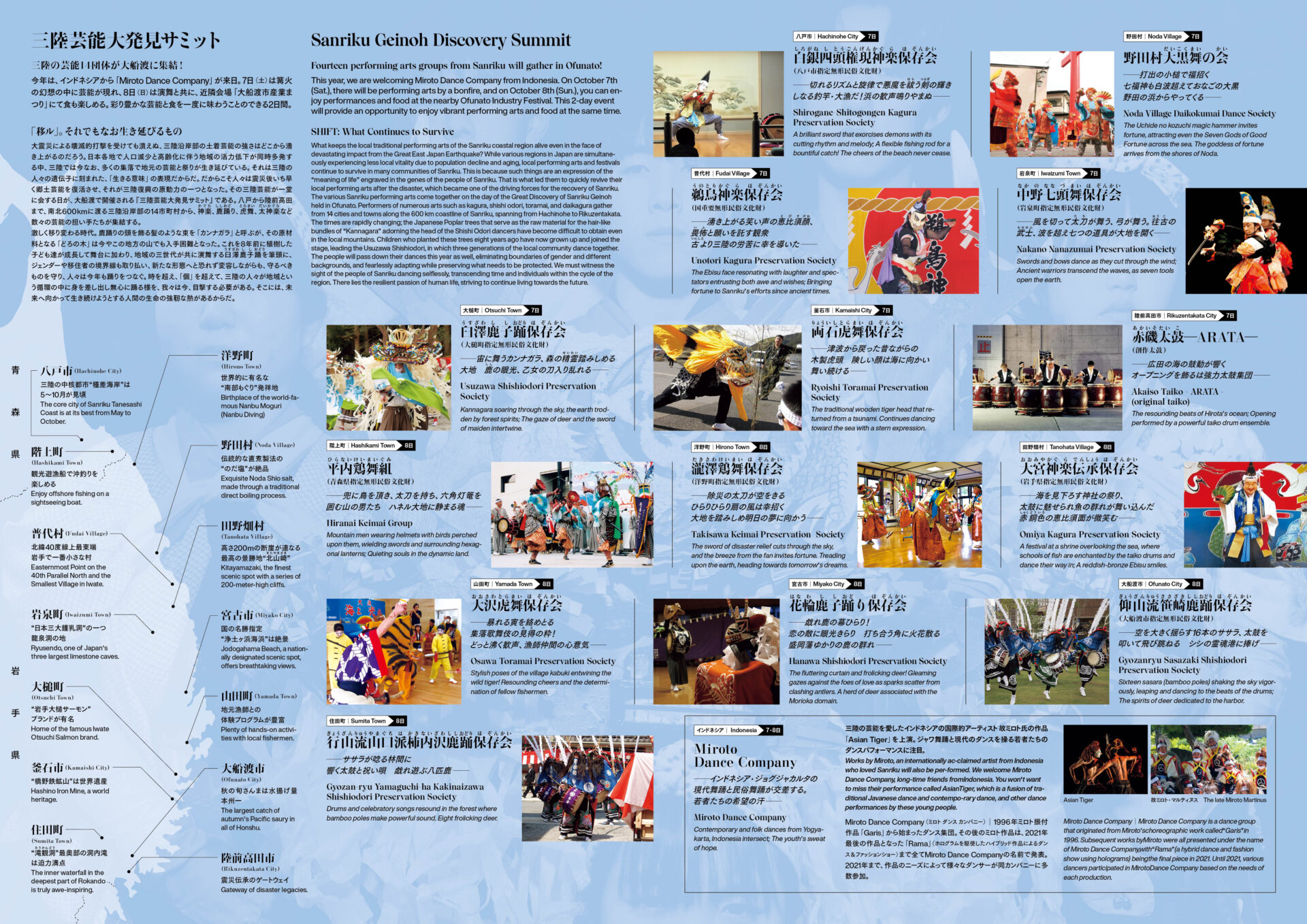EVENT
Sanriku Geinoh Discovery Summit October 7 (Sat.) – 8 (Sun.), 2023
- 2023
- Interact
- Appreciation
-
Date
October 7 (Sat.) - 8 (Sun.), 2023
-
Time
7 (Sat.)| Opens: 2:45PM Starts: 3:30PM Ends: 8:30PM 7 Sanriku groups, 1 Indonesian group Break (45 mins.)
8 (Sun.)| Opens: 10:00AM Starts: 10:45AM Ends: 3:30PM 7 Sanriku groups, 1 Indonesian group Break (45 mins.) -
Locate
Kyassen Ofunato (Suzakigawa Shinsui Hiroba)
*In case of rain – Ofunato Community Center -
Fee
Free admission
Advance reservations required for front seats only (limited to 200 seats, certain date and time, free choice of seats).
Standing area and rear seats (no reservation required) are also available.

Date&Time
7 (Sat.)Opens: 2:45PM Starts: 3:30PM Ends: 8:30PM 7 Sanriku groups, 1 Indonesian group Break (45 mins.)
8 (Sun.)Opens: 10:00AM Starts: 10:45AM Ends: 3:30PM 7 Sanriku groups, 1 Indonesian group Break (45 mins.)
Locate
Kyassen Ofunato (Suzakigawa Shinsui Hiroba)
12-33 Nonoda, Ofunato-cho, Ofunato, Iwate 022-0002
*In case of rain – Ofunato Community Center
10-14 Myojinmae, Ofunato-cho, Ofunato, Iwate 022-0002
■ Performance ■
Fourteen performing arts groups from Sanriku
↓Aomori prefecture
Hachinohe City|Shirogane-Shitogongen Kagura Preservation Society
Hashikami Town|Hiranai Keimai Group
↓Iwate prefecture
Hirono Town|Takisawa Keimai Preservation Society
Noda village|Noda Village Daikokumai Dance Society
Fudai village|Unotori Kagura Preservation Society
Tanohata Village|Omiya Kagura Preservation Society
Iwaizumi Town|Nakano Nanazumai Preservation Society
Miyako City|Hanawa Shishiodori Preservation Society
Yamada Town|Osawa Toramai Preservation Society
Otsuchi Town|Usuzawa Shishiodori Preservation Society
Kamaishi City|Ryoishi Toramai Preservation Society
Ofunato City|Gyozanryu Sasazaki Shishiodori Preservation Society
Rikuzentakata City|Akaiso Taiko – ARATA – (original taiko)
Sumita City|Gyozan-ryu Yamaguchi-ha Kakinaizawa Shishi-odori Preservation Society
↓Indonesia
Miroto Dance Company
Works by Miroto, an internationally acclaimed artist from Indonesia who loved Sanriku will also be performed.
We welcome Miroto Dance Company, long-time friends from Indonesia. You won’t want to miss their performance called Asian Tiger, which is a fusion of traditional Javanese dance and contemporary dance, and other dance performances by these young people.
■ Ticket Information ■
Free admission
Advance reservations required for front seats only (limited to 200 seats, certain date and time, free choice of seats).
Standing area and rear seats (no reservation required) are also available.
Reservations
Reservations will be accepted from August 10 (Thu.), 2023 by numbered tickets or online.
1.online ticket
Online tickets: https://ws.formzu.net/dist/S115714085/
*Up to one ticket per person per application.
2.Numbered Tickets
Distribution Period: August 10 (Thu.), 2023 – September 30 (Sat.), 2023
Ofunato City Disaster Prevention Tourism Exchange Center Ofunaport Reception Counter
– Rias Hall, Ofunato Civic Cultural Hall
*Up to 3 tickets per person.
*Distributed during the location’s opening hours.
■ access ■
●By car
From Sendai: About 9 minutes from Ofunato Goishi Kaigan IC on the Sanriku Expressway
From Morioka: About 60 minutes via Route 107 from Miyamori IC on the Kamaishi Expressway
From Miyako or Kamaishi: About 11 minutes from Ofunato IC on the Sanriku Expressway
Due to the limited parking spaces available, we ask that you use public transportation as much as possible.
We apologize for any inconvenience and appreciate your understanding.
●By direct bus
From Sendai: Sendai Station to Sun-lia Shopping Center Mae (about 3 hours)
Sun-lia Shopping Center Mae or Sakari Station to Ofunato Station (about 6 minutes)
From Morioka: Morioka Bus Center or Morioka Station to Ofunato Station (about 3 hours and 30 minutes)
●By train or BRT
Via JR Ichinoseki Station
◼From Sendai
JR Shinkansen: Sendai to Ichinoseki (about 30 minutes)
◼From Morioka
(1) JR Tohoku Line: Morioka to Ichinoseki (about 1 hour and 30 minutes)
(2) JR Shinkansen: Morioka to Ichinoseki (about 40 minutes)
-From JR Ichinoseki Station-
(1) Bus: Ichinoseki Station to Ofunato Station (about 2 hours and 15 minutes)
(2) JR Ofunato Line: Ichinoseki to Kesennuma (about 1 hour and 30 minutes)
JR Ofunato Line BRT Rapid: Kesennuma to Ofunato (about 1 hour and 10 minutes)
Via JR Kamaishi Station
◼From Morioka
JR Tohoku Line: Morioka to Kamaishi (about 2 hours and 30 minutes)
Sanriku Railway: Kamaishi to Sakari (about 45 minutes)
BRT (bus): Sakari to Ofunato (about 5 minutes)
*Please check schedules in advance if you plan to use public transportation, as the frequency of service is limited.
*In case of rain, a free shuttle bus will be available from Ofunato Station to Ofunato Community Center.



Areas
-
Hachinohe City
-
Hashikami Town
-
Hirono Town
-
Noda Village
-
Fudai Village
-
Tanohata Village
-
Iwaizumi Town
-
Miyako City
-
Yamada Town
-
Otsuchi Town
-
Kamaishi City
-
Ofunato City
-
Rikuzentakata City
-
Sumita Town
Artists
-
Shirogane Shito Gongen Kagura Preservation Society
The Shirogane Shito Gongen Kagura has been inherited in Shirogane community in Hachinohe city. It falls in the category of yamabushi (mountain hermit) kagura which performs ritualistic or theatrical pieces according to contexts such as prayer for safety of family, bountiful crop or rich haul, exorcism, and service for the dead, visiting temples, shrines and houses with shishigashira worshipped as gongen-sama. Their current repertory consists of 18 items. In Hachinohe, they are the only group that maintains the female dance, meanwhile their theatrical pair dance is only shared by the Same Kagura. The Shirogane Shito Gongen Kagura, typically in Hachinohe, can be considered as a part of the same lineage of kagura in the northern part of Iwate prefecture, regarding the performance structure and rhythm. Despite its similarity with the Same Kagura, many gestures are found specific to this dance.
-
Hiranai Keibai Group
Keimai, a dance with headdress imitating chicken’s head, is considered as a form of nenbutsu odori in connection with the cult of chicken as exorcist, transmitted from Kesen region belonging to Sendai domain in Ansei era (1854-1859).
The items of the Hiranai Keimai are comprised of haka nenbutsu (prayer in front of tomb), butsudan nenbutsu (prayer in front of Buddhist altar) and niwaodori (garden dance). The latter keeps nine pieces as its repertory in their original form. -
Noda Village Daikokumai Dance Society
“Daikokumai” is a traditional dance to bring luck in. “It is a traditional dance of “Koshogatu” (first full moon festival) performed in 2022’s “Noda Festival” (the biggest event of Noda Village) and the 5th “Sanriku Coast Local Performing Arts Performance” in 2022 for the first time in three years.
-
Unotori Kagura Preservation Society
The Unotori Kagura is a typical yamabushi (mountain hermit) kagura. It worships shishigashira into which the spirit from Unotori Shrine in Torii, Fudai village entered. It tours villages to pray for a rich haul, a bountiful crop and safety of family from January to March every year. The tour proceeds in Iwate, northbound to Kuji city and southbound to Kamaishi city in alternating years. Local residents host the kagura intimately calling “Unotori sama.” Since this form of the tour is unique and it maintains rare customs, Unotori Kagura is designated as the Intangible Folk Cultural Property by the state in 2015.
-
Omiya Kagura Preservation Society
The Omiya Kagura is a yamabushi kagura brought by Eifuku-in, a yamabushi belonging to Haguro school and an administrator of Omiya Shrine at that time, in 1337. With the shishigashira which is given the spirit from Omiya Shrine in Raga, Tanohata village, the kagura is the dance of prayer for well-being, such as warding off evil spirits, fire safety, sound health, security of family, bountiful harvest, rich haul or good business. The characteristic of this kagura is in its vigorous and dynamic way of dancing in the triple meter.
-
Nakano Nanazumai Preservation Society
Nakano Nanazumai is a folk performance art handed down in the Omoto Nakano district of Iwaizumi Town. It is said to have origins dating back to the 1840’s , when Kitaro Kudo, who was called Kagura Tayu ”Master of Kagura Sacred Dance” at the time, created it by using the beginning portion of a kagura dance as its basic inspiration. The performers include 7 pairs of dancers doing 7 different dance segments that are named Dogu-tori, Yoko-hane, Chirashi, Tatakai, Tsuttōtsu, Sansoku “Torii-gakari”, and Dogu-osame. At the time, these were performed as kagura sacred dances, but as times changed, they became integrated into the village festival. Nakano Nanazumai is a gallant and lively dance entreating an abundant harvest, big catches in the sea and the general safety of the village. The strong and graceful dance imagines the hard work of preparing new fields, then raising precious crops, and finally thankfully celebrating that year’s harvest all together with fellow villagers.
-
Hanawa Shishiodori Preservation Society
Hei Yorimoto, who had made his home at Nejo Castle, had a vassal called Hanawa Jiro who was a performing arts enthusiast. This Hanawa is said to have learned this dance while traveling around in Echigo. In 1631, he accompanied Nanbu Shigenobu – the twenty-ninth head of the Nanbu clan, affectionately known as “Hanawa Tonosama” (Lord Hanawa) – when the latter was summoned to Morioka from Hanawa. He performed the dance at Morioka Castle, and was granted the use of the Nanbu clan’s kuyo (nine-star) and mukaizuru (facing cranes) crests.
Every year, the dance is dedicated to the gods at Hanamori Shrine’s annual festival in April, and is performed on August 15 during the Bon Festival at the Hanawa Tradition Museum, to pray for the souls of ancestors. -
Osawa Toramai Preservation Society
It is said that in the Edo period, sailors learned the toramai in Edo or Nagasaki, and passed it on when they returned to their hometowns.
-
Usuzawa Shishiodori Preservation Society
Allegedly there used to be a form of dance which had been conveyed by a sailor from Boshu (the tip of Boso peninsula, current Chiba prefecture) during the Genroku era (1688-1704). Today’s Usuzawa Shishiodori is said to have originated from the dance in Boshu which the villagers of Otsuchi learned during their travel to the Kashima Shrine in the Tenmei era (1781-1789). Today, they dedicate the dance at Otsuchi Festival of the Kozuchi Shrine and join the procession of mikoshi (a portable shrine) as its advance unit, dedicating the dance at stations of mikoshi and visiting houses for ritual. The dance is also dedicated at the festival of a branch shrine of the Kozuchi Shrine in Usuzawa community. Although the number of households in Usuzawa community is limited, all of them are contributing to the Preservation Society. It includes some members visiting from other communities. The dance is intense and wild with swinging hair-like ribbons called kan’nagara, made of shaved Japanese wood pulp.
-
Ryoishi Toramai Preservation Society
Ryoishi Toramai is said to have originated in the mid-Edo period as a prayer for a safe voyage and bountiful catch. Although the entire region suffered significant damage from multiple tsunamis and many valuable records were lost, the dance form has been passed down without alteration to this day.
It is primarily performed during the Ryoishi Festival (regularly held at Itsukushima Shrine) and other events in Ryoishi Town.
The distinctive features of Ryoishi Toramai include the movements of the tiger head, footwork, and the interchange of dancers during the performance. The accompanying music, such as the sounds of the taiko drums, the tones of the clear flute, and hand cymbals along with shouts (“dome”) harmonize with the dancers as they vigorously swing the tiger heads, while their footwork resembles the stomping of sumo wrestlers. -
Gyozanryu Sasazaki Shishiodori Preservation Society
In 1768, a man named Risota returned home from Shizugawa village (today,Minamisanriku Town,Motoyoshi District,Miyagi Prefecture) in Motoyoshi district, bearing a scroll certifying him as the inheritor of this dance. He was later adopted by the Osorei family in Sasazaki, Ofunato, and introduced the dance to the district. The chief of the Date clan praised the dance and granted Risota the akakuyo (red nine-star) crest of a fief-holder, the epithet of “gyozan,” (which means “rare,” “extraordinary”) and the frontal cloth with bird feathers. This is the precious ancestral heritage.
-
Akaiso Taiko -ARATA-
Formed in 1991 to promote the spread of traditional Japanese taiko drums, this group from Tomari, Hirota Town, consisting mostly of young members, has performed numerous times at the local Kurosaki Shrine festival.
In 2015, at the first festival following earthquake, they released new musical pieces and expanded their performances to various events and visits to elderly care facilities. Since 2017, they have been active under the new name Akaiso Taiko – ARATA – with the intention of revitalizing Rikuzentakata.
Currently, they diligently practice every day, putting their souls into each beat and energetically performing in various places to touch the hearts of audiences. -
Miroto Dance Company
Miroto Dance Company is a dance group that originated from Miroto’s choreographic work called “Garis” in 1996. Subsequent works by Miroto were all presented under the name of Miroto Dance Company, with “Rama” (a hybrid dance and fashion show using holograms) being the final piece in 2021.
Until 2021, various dancers participated in Miroto Dance Company based on the needs of each production.
Contact
Minna no Shirushi LLC
6-4 Aza Kimachi Sakari-cho, Ofunato City, Iwate 022-0003
TEL | 0192-47-5123 FAX | 0192-47-5125
E-mail | minna@mi-kuni.com
Sanriku International Arts Festival 2023
-JAPAN CULTURAL EXPO 2.0
Organized by|Sanriku International Arts Committee, Japan Arts Council, and Agency for Cultural Affairs, Government of Japan

Co-organized by|Hachinohe City, Hashikami Town, Hirono Town, Kuji City, Noda Village, Fudai Village, Tanohata Village, Iwaizumi Town, Miyako City, Yamada Town, Otsuchi Town, Kamaishi City, Ofunato City, Rikuzentakata City, Sumita Town, Sanriku Railway Co., Ltd., Japan Folk Performing Arts Association, NPO Iwate Arts Support Center, and NPO Japan Contemporary Dance Network
Cooperated by|NPO Michinoku Trail Club, imajimu LLC, Tohoku Cultural Property Video Research Institute, Minna no Shirushi LLC